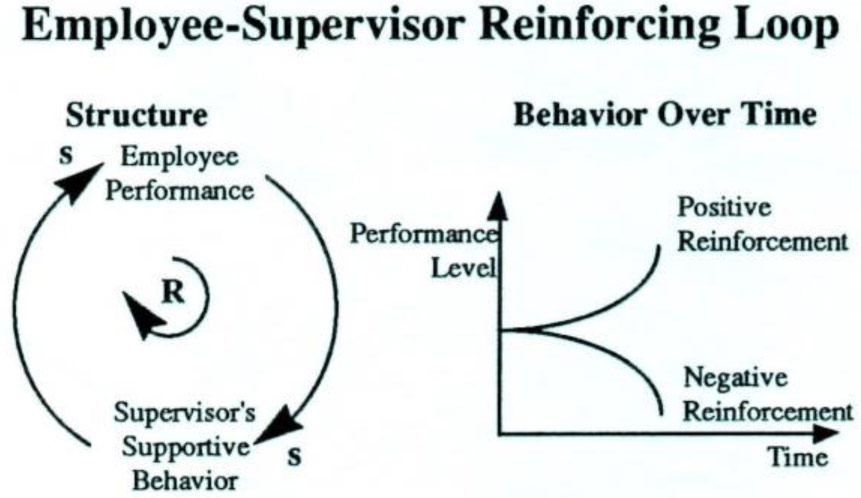In the book The Double Helix James Watson describes the process through which he and Robert Crick “cracked” the DNA code. While others were searching for complex structures to explain the diversity of life forms, Watson and Crick explored more simple geometrical designs. They eventually received a Nobel Prize for revealing the double helix structure that is the genetic basis for all life. Through their research, Watson and Crick proved that the infinite variations we see in nature can all be produced by one simple, elegant structure.
Similarly, two basic loops — reinforcing and balancing — can be seen as the equivalent building blocks of complex social and economic systems. These simple structures combine in an infinite variety of ways to produce the complex systems that we as managers are expected to control.
Engines of Growth and Decay
Reinforcing loops produce both growth and decay. That is, they compound change in one direction with even more change. For example, in the employee-supervisor reinforcing loop below, positive reinforcement from the supervisor is capable of producing good employee performance, while negative reinforcement can produce poor employee performance over time.
Goal-Seeking Processes
Of course, most things in life cannot continue growing forever. There are other forces — balancing loops — which resist further increases in a given direction. Balancing loops try to bring things to a desired state and keep them there, much like a thermostat regulates the temperature in a house.
Employee-Supervisor Reinforcing Loop

An equivalent example in manufacturing involves maintaining buffer inventory levels between production stages. In this situation, there is a desired inventory level which is maintained by adjusting the actual inventory whenever there is too much or too little.
Inventory Control Balancing Loop

Using the Building Blocks
To see how these two basic loops can combine to form more complex structure-behavior pairs, let’s revisit the employee-supervisor feedback loop. Clearly the employee’s performance will not improve indefinitely just because the supervisor is supportive. The employee may have been putting Negative in longer hours in Reinforcement order to continue Time impressing the supervisor. Over a period of time, the increased work hours may begin to wear down the employee’s energy level. If this continues, at some point the supervisor’s supportive behavior will be eclipsed by the sheer energy drain of working long hours. Improved performance will gradually be offset by the effects of burnout, until finally the balancing loop connecting energy level and hours worked becomes dominant. At this point the employee’s performance will either plateau or decline.
Reinforcing Loop Coupled with a Balancing Loop

Summary Points
All complex dynamic behavior is produced by two loops: reinforcing and balancing. Behind every growth or decay is at least one reinforcing loop. For every goal-seeking behavior, there is a balancing loop.
A period of growth followed by a slowdown in growth is usually caused by a shift in dominance from a reinforcing to a balancing loop.
Next issue: Balancing loops with delays.
